As all these white papers do, they begin with an answer to a question. More than one this time as first, it was a fellow inquiring about powering a servo in a TEKNO SCT410 2.0 using the 2S propulsion pack, and then not 5 minutes later, another guy asking a question. This time about which servo is best for the TEKNO RC SCT410 V2.0. So two questions within 5 minutes and both dealing with the same rig!
Like all great companies, TEKNO RC is predictable in one thing. It's that once they release something really good, they immediately begin to iterate and improve on it. In this regard, they're a lot like Porsche because just like a Porsche 911 is recognizably the same decade on decade (but because they're always developed year-on-year), eventually it's no longer the same car because nothing fits from one generation to a previous generation's.
Same with TEKNO RC whose STC410.3 was so refined and highly developed, they couldn't materially improve it. So they started with a clean sheet of paper. The result being the 2.0 which is an entirely new generation of the near decade old 410 design.
Thus, over and over, the best manufacturers perform the so called rinse-repeat cycle of iterative improvements. Why? Simple, it's because it gives birth to steady advancements for the better - until it's as good as it's going to get. E.g. the famous 410.3 short course truck, and then we get a generational leap to the SCT410 2.0.
ProModeler also continuously develop our servos, like our near decade old DS470BLHV was steadily improved year by year until an entirely new motor made releasing it as the DS505BLHV, a smarter move. While it's a nearly identical looking servo, inside, it's totally different!
Anyway, after iterating through 410.3 TEKNO has made a leap. And not a generational improvement, but a revolutionary one! It's a milestone for the 1/10th scale short course truck class - 2.0 - and yes, it is a big deal.

What's different from 410.3 to 410 2.0? Virtually everything! This is an all new short course truck and predictably, questions soon began flowing to us about outfitting it with a ProModeler servo. First up, regarding the best way to power the servo, then other questions, too. So let's delve into them in the order they've arrived and go from there.
And note, as this is a living document, which merely means as we get more questions, we'll add them and respond here, in due course. So first up, a question regarding powering the servo off the propulsion pack (this, because this rig is suitable for 2S through 4S packs).
Basically, the fellow wants to use a high voltage 2S LiPo to power the rig, and parasitize from it for the control electronics. And if not this, he wonders about relying on the BEC, instead. So here we go!
Q. I have a question regarding the DS415BLHV servo. I'm looking to purchase a short course race truck, the TEKNO SCT410 2.0, and was wondering if I could run the servo direct from a 2S high voltage propulsion pack? I know the specs on the servo show 8.4 volts but I was wondering if it could handle 8.7 volts? If not, is this a case where it would be best to run it off the BEC of the ESC? I would rather not add the weight of a separate battery.
A. Nope, don't try running a ProModeler servo off 8.7V instead of 8.4V because it's not rated for that level of voltage. Might work for a while, but also might go poof . . . immediately. No telling but trust me, this is a bad idea and operation beyond 8.4V means you're on your own, sorry.
But beyond this, buried within your question is one regarding running the servo off the propulsion pack, and if this is what you're asking, then this is trouble, too. Here's why . . .
There are two reasons you never want to do this. First one is to do with the ripple and noise being generated by the propulsion system. It's going to back feed into not just the servo *but also* into the delicate receiver's PCB. This is bad juju.
Second, on a practical level, it subjects the servo to varying voltage (as the rig is accelerated and decelerated). And no offense, but this is a downright stupid thing to do.
Why? Simple, as you lean on the throttle, the pack voltage drops. As you ease off the throttle, pack voltage spikes up. So it's NEVER any constant value like 8.2V, at best it's 8/2V for only fractions of a second. I'm saying voltage is *always* varying because you're on and off the throttle continuously with a short course truck.
So imagine driving your car with variable power steering. Like harder to steer sometimes, too freaking easy at other times. This is a disaster, especially when racing, because if the steering lacks a consistent response, how can you possibly get consistent performance? If the steering response is always changing . . . you can't!
And the reason you can't is because of the physics of the varying voltage. Nothing to do with the skills of the driver. It's 100% down to physics!
Remember, what a racer depends on from his steering is consistency, else he can't do his best laps if the servo reacts different based on the acceleration or deceleration of the motor driving the rig. In short, with varying voltage he's screwed!
Eyeball this chart for the DS415 to begin to grok. Look only at speed and torque based on each of five different input voltages.
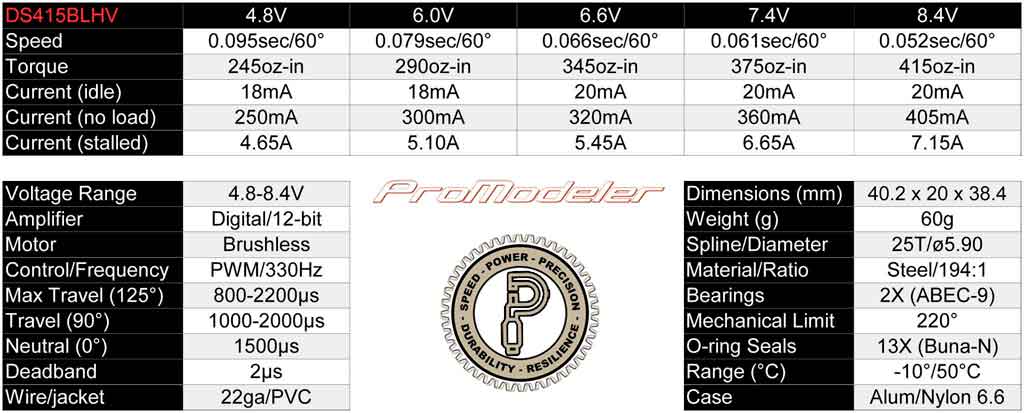
You'll immediately note this chart is divided into 5 different voltage ranges, these being 5V, 6V, 6.6V, 7.4V, and 8.4V. Take note how torque and speed *both* vary depending on the voltage level. More voltage means more torque *and* faster response.
So on a practical level, it means if your servo sees varying voltage, then you're going to get inconsistent response from your high dollar servo. Heck, you'll get an inconsistent response from an el cheapo servo, too.
And this isn't just my opinion, it's 100% down to physics. May as well argue with gravity's existence. Bottom line? Please don't go powering the control electronics from the propulsion pack. Just don't go there!

Next, about whether a BEC is enough, dunno, try it if you like but remember one thing; BECs weren't developed for performance, they're about saving money. Traxxas invented BEC circuits decades ago expressly so they could leave out the control power battery pack (this, in order to hit price targets). So BECs are about saving money but the SCT410 2.0 is a race truck. Performance, not economizing. Totally different goals.
So maybe the BEC supplies enough current at the rated voltage for some toy-like consumer-grade servo - but for one of ours, or anything of similar capabilities? Nope, not a chance! Just look at the current requirements at whatever voltage you want to run (refer to the DS415 performance chart, again).
Anyway, it's far more likely the BEC lacks the stones to power your servo to rated performance. True especially if there is only one lead coming off the ESC to the receiver (typically the throttle lead) because a single lead connector is rated at 3.5A, and this is not enough.
So this brings me to . . . everything I'm telling you about our servo holds true for every other brand of servo with similar performance, not just ours. Why?
It's because of physics. That other manufacturers remain schtum about these issues merely results in ignorant modelers, but with regard to the physics? Physics don't care what you or I, think! Physics falls under the category of *it is, what it is* . . . so if you don't believe in gravity, go jump off a 5 story building and see if gravity cares about an opinion!

Alternative sources to using the propulsion pack for power
So what's your alternative if you don't want to carry a dedicated 2S pack for control, and the BEC on your ESC only has the one lead feeding the receiver? Note, the one lead is the wire from the ESC to the receiver. This lead is typically black, white, and red (or brown, orange, and yellow).
Since one lead is limited to 3.5A continuous (go look at the chart for Amp draw at each voltage range above and you'll see why 3.5A won't cut it), then you need either an inexpensive battery pack with two leads, or an after market BEC, also with two leads.
We offer a good one. Comes from Castle Creations. It's their CC BEC Pro 2.0 WP. Yes, it's a bit expensive but it'll do the job because it's equipped with two power leads instead of one. And since each is good for 3.5A, then 3.5+3.5=7A continuous, then it'll do the job.
Or, use a small battery like a B2S850-15C (also equipped with two leads). How much current will it deliver? Fair bit more than the CC BEC Pro 2.0 WP. The small pack is capable of 0.85Ax15C=12.75A, or a continuous current that handily exceeds what the two leads can deliver without overheating (remember, the pack doesn't push the current, the servo sucks the current from the pack, so with 12.75A capability, it offers you more than enough current to do the job).
Note, remember Voltage (V) and Current (A) are two totally different things. Voltage is a level, current is related to flow. That, and current is what actually makes things happen. Don't get confused. Read up about this stuff here;
So with regard to powering a good quality servo, ours or anybody else's, then your real world alternatives are either a dedicated 2S pack or a pricey BEC (and it must be one that has two power leads because the limiting factor isn't what it's rated for, it's the connector and the connector is rated to 3.5A continuous). I'm sorry if it seems like I am beating on a dead horse but it helps some to repeat things and I want to get the concept of flow across because everybody knows all about voltage but seemingly everybody is in the dark about flow. But current flow is the single most important consideration.
And if this doesn't accord with the worldview of some faceless opinion holder online, then I'm sorry but I'm an engineer. Means I'm not into fairy tales or unicorn farts. These numbers are the real world, not what BilieZtan (who may well be some 12 y/o kid who doesn't know his ass from a hole in the ground but is dispensing advice like a pro on a forum or Facebook).
- Real servos need real current to make rated power, not make believe.

Q. Wondering which servo is best for my new TEKNO SCT410 2.0 I just ordered from AMain. Haven't received it yet, so I need to get my servo ordered as quickly as possible so I can jump on this bad boy!
A. The answer to which is our best servo is . . . it depends.
We're going to discuss five servo alternatives and leave it to you to decide what's best for *you*. These being two hybrids and three all-alloy construction servos.
What they have in common is all five use all-steel gears and brushless motors instead of all-metal gears and coreless motors. Steel is the better metal for gears. And if you don't know diddly about servo motors, then review this.
Maybe even save it to your phone to have reading material for the throne because it's somewhat involved. Why?
It's because we took the three various motor types all servo manufacturers use (iron pole, coreless, and brushless) and cut them open with a lathe. Then we photographed their guts to show you what's what.

Five ProModeler servo recommendations
We have five pretty darn good alternatives servo-wise for a short course truck and which one is best for you, depends.
Two of them feature hybrid construction to save weight. Their servo case features an all alloy center (the finned porcupine case) plus a bronze reinforced glass-filled nylon upper and electronics cover. These are our DS255BLHV and DS415BLHV.
And the other three feature a significantly stronger all-alloy case; the DS505BLHV, DS635BLHV, and DS490BLHV. And the latter two features the ginormous 15T spline we use on our servos outputting north of 2500oz-in.
All the others use the common as dirt 25T spline. Both 25T and 15T are ISOs, meaning developed by standard bodies, and thus available from anybody, e.g. not brand specific.
As usual, clicking any of the above links opens a new tab in your browser (so you don't lose your place whilst reading here). First up, the hybrids.

DS255BLHV and DS415BLHV
We'll deal with the DS255BLHV and DS415BLHV together because they're variations on a theme, one is just more powerful than the other but otherwise, they're as alike as two peas in a pod (and both are faster than a goose dumping a load before taking flight).
First, both have the super strong alloy center case, which is CNC-machined from a solid billet of Alcoa 6061-T6 aircraft aluminum. We call this section the porcupine due to the 10-bolts sticking out of it, which are used to secure the transmission section and electronics cover to this foundation piece. These 10 bolts holds this servo together securely!
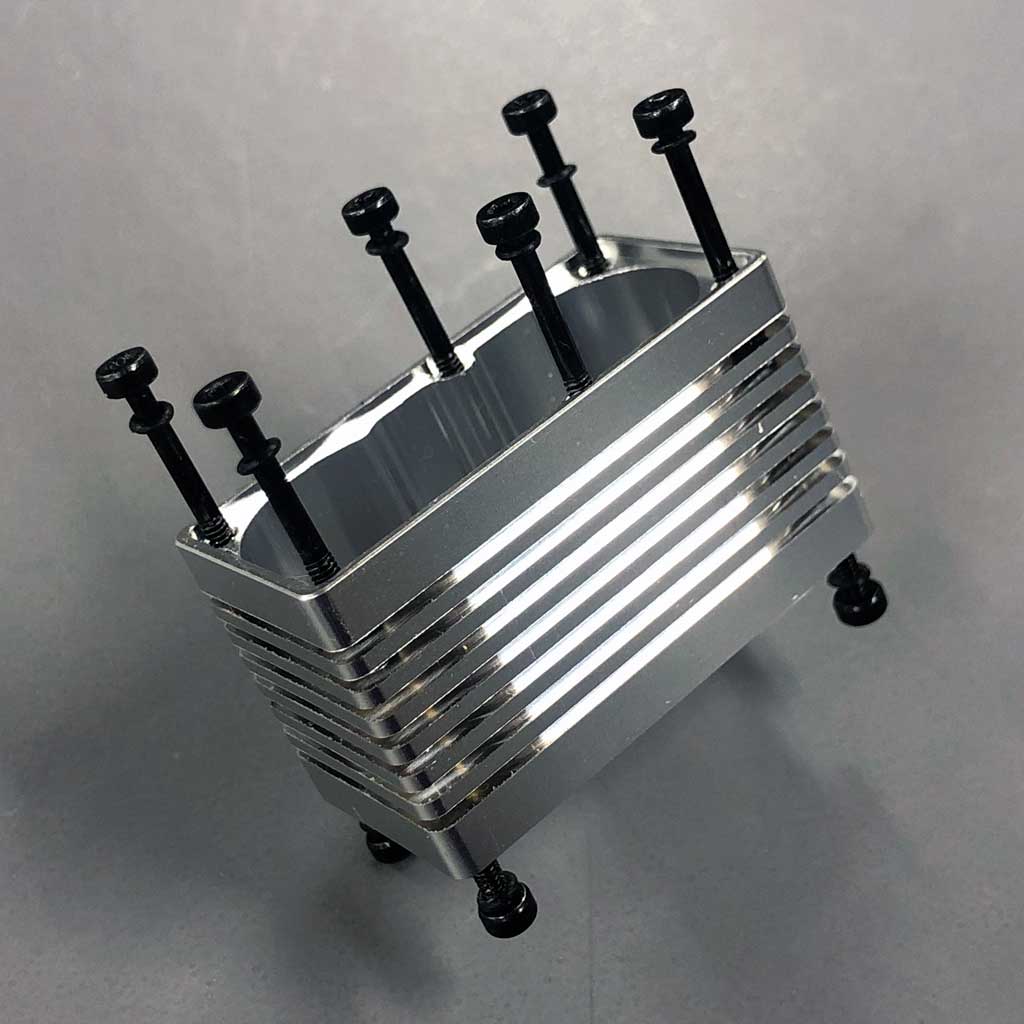
- Note the teeny-tiny o-rings used for sealing!
Take special note of the cooling fins. They're not decorative. What do I mean? When it's working hard, a servo is needing to shed heat. A *lot* of heat. How much?
Well, from the specs you remember the DS415 can hit 7.15A of current draw at 8.4V, so from the power formula, Watts equal Volts x Amps, then using grade school math we multiply one and the other (8.4Vx7.15A) and get 60.06W . . . so let's call it a 60W device. That's a lot.
While you probably know better than to touch a 60W bulb, have you ever inadvertently touched a 5W Christmas tree light, or a 15W refrigerator bulb? Burned the crap out of you, right?
So here's the thing, because servos need to be able to shed heat when they're working, we use cooling fins to help radiate the heat out of the device. The technical term is dissipate.
Reason for doing this is because the servo's motor and electronic components will last longer since heat is what kills electronics. Why do the el cheapo servos leave off the cooling fins? Simple, it's down to just because it's expensive to mill the fins into the case!
So the porcupine design is the best there is, we won't brook none of those cheap techniques of using an extrusion and long ass bolts to clamp the electronics cover and center to the transmission section, OK? Every ProModeler servo uses machine-thread bolt threaded into the center to get the best holding force.
Thing is, precision boring and tapping for ten tiny bolts is expensive (expensive in terms of machine-time because time is money, e.g. the longer anything takes to do, the more it costs). And lowering their production cost is why el cheapo servos don't do it this. After all a Kia and Mercedes both have four wheels and will get you to work, but is there any doubt which one is built better? Same holds with ProModeler where you get what you pay for.
So regarding our porcupine center section; we're as proud of our creation as your Daddy was when he was showing off photos of his new son (that would be you) to his pals at work, believe me! What's next? The hybrid sections.
We injection mold the hybrid case sections with glass-filled nylon it's called Nylon 6.6 and it's the same stuff Glock uses for handgun side frames because it's touch and impact resistant. But despite being tough, it's not tough enough to withstand the forces of the steel gear shafts so we reinforce where these are fitted.
Eyeball this photo to see what I mean. Those shiny bits? Those are Swiss turned bronze which are insert molded.
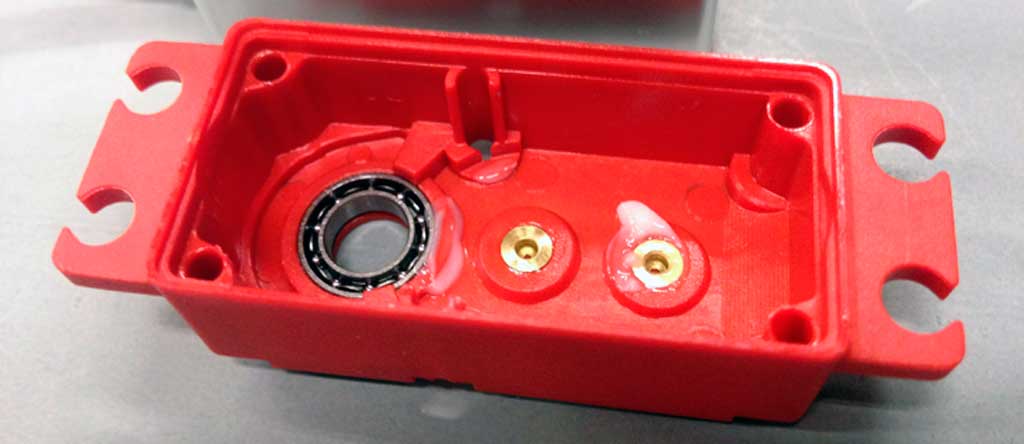
- Super lightweight and strong, the hybrid case servo is a design marvel
So when you put the two together, you get strong and lightweight, both! Is there a downside? Unfortunately, yes. The downside is in a crash, you may destroy the polymer case components. Add the cost of gears to the case and repair gets iffy because it's then a significant fraction of buying a new one. Do you always break the case? no, of course not. Why bring it up? What, you want us to blow smoke up your skirt and say nothing? Sorry, not how we roll.
Anyway, if the performance suits your needs, then one of our hybrid case servos is the cat's meow in the lightweight high performance servo world.
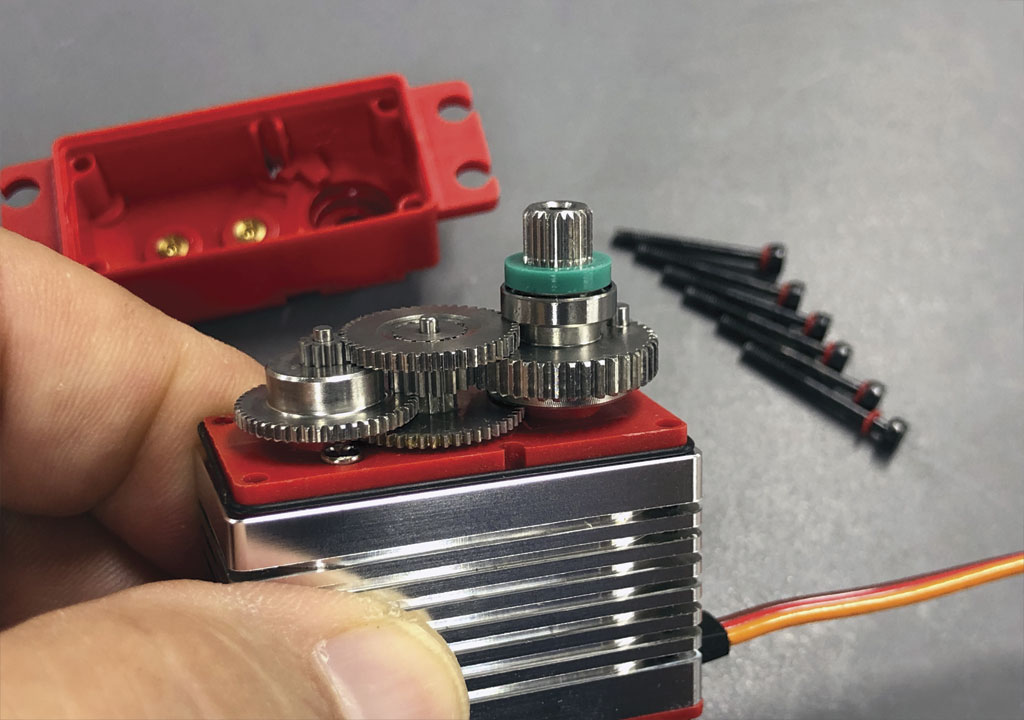
- The ultimate lightweight, a ProModeler hybrid construction servo

So what's the solution if you can stand to bear a bit more weight? Simple, one of our all-alloy servo offerings. We suggest maybe DS505BLHV, DS635BLHV, or DS490BLHV low profile will suit you to perfectly. The first one up is the DS505BLHV.
ProModeler DS505BLHV is our best all arounder
The DS505BLHV is our bread-and-butter brushless alloy servo for good reason. Offered for just 100 bucks, the servo meets MIL-STDS and is far and away our most popular servo offering for short course truck competition.
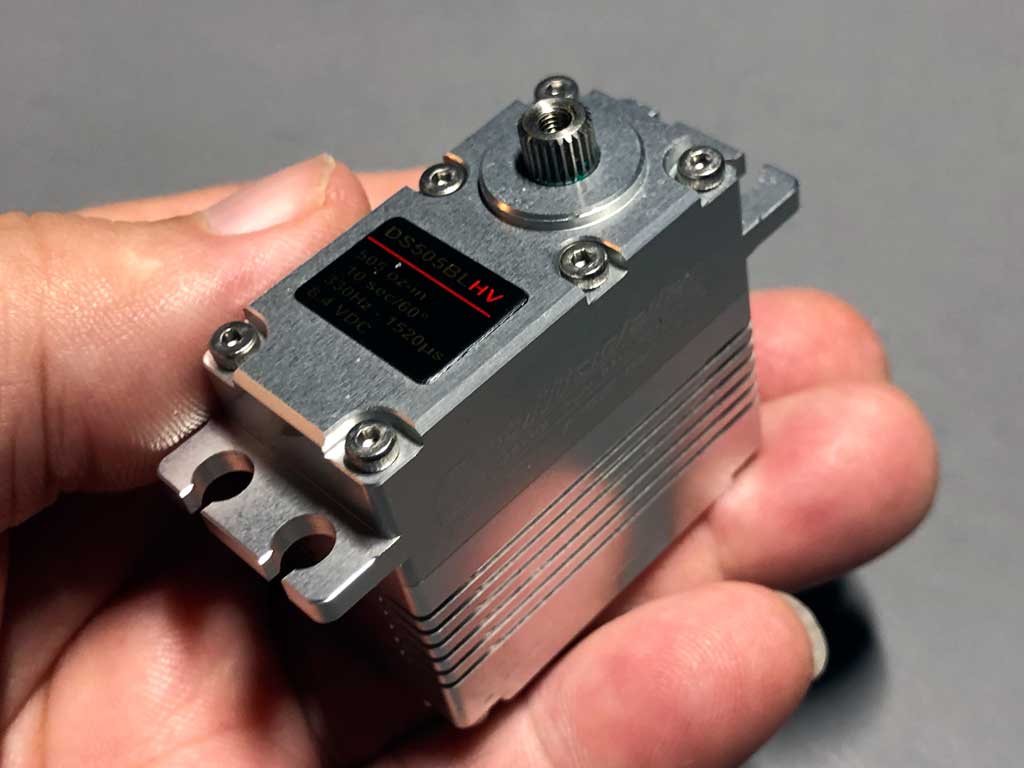
- Our best all arounder, the ProModeler DS505BLHV
So while you can read up on the DS505BLHV and learn about its features and what benefits they bring you, obviously you'd expect it to be a great servo. So how would you like to learn what it's like after it breaks?
Think maybe *this* will better inform you about how it'll hold up for your use? If so, then take a few minutes and review this:
If you find it strange for us to show you damaged servos (and what's involved in making them work like new again), don't be surprised because . . .
- we make them, and
- we can fix them, and
- we're not pretending they're unbreakable
This brief article may in fact, better inform you about this servo than anything we can say about how wonderful they are. After all, we're not immune to extolling the virtues of what we produce - we're human, right?
So all you need are a pair of Eyeballs Mk II to see for yourself what you'll get. In this we're unique on the market in showing you the guts of our products. This is good for the same reason, Beauty is Only Skin Deep became a saying when the competition won't show you theirs, eh?
What's next servo-wise? Our baddest competition servo is probably our DS635BLHV, so let's yap about this one a little bit.

ProModeler DS635BLHV the bad boy in our lineup
Fast, smooth, powerful, excellent centering, and tough as nail is a fair description. Pricey, is too. Of the five we'd probably guide you to this one for an SCT410 2.0, but it also costs the most. Can't be helped. Larger bearings, larger gears, larger shafts, etc.
The DS635BLHV shares the same construction as our DS490BLHV, DS845, and DS1155 in terms of all four are BLS2 class servo. These are our very best. Defines getting what you paid for. Look how it's built compared to a popular competitor.
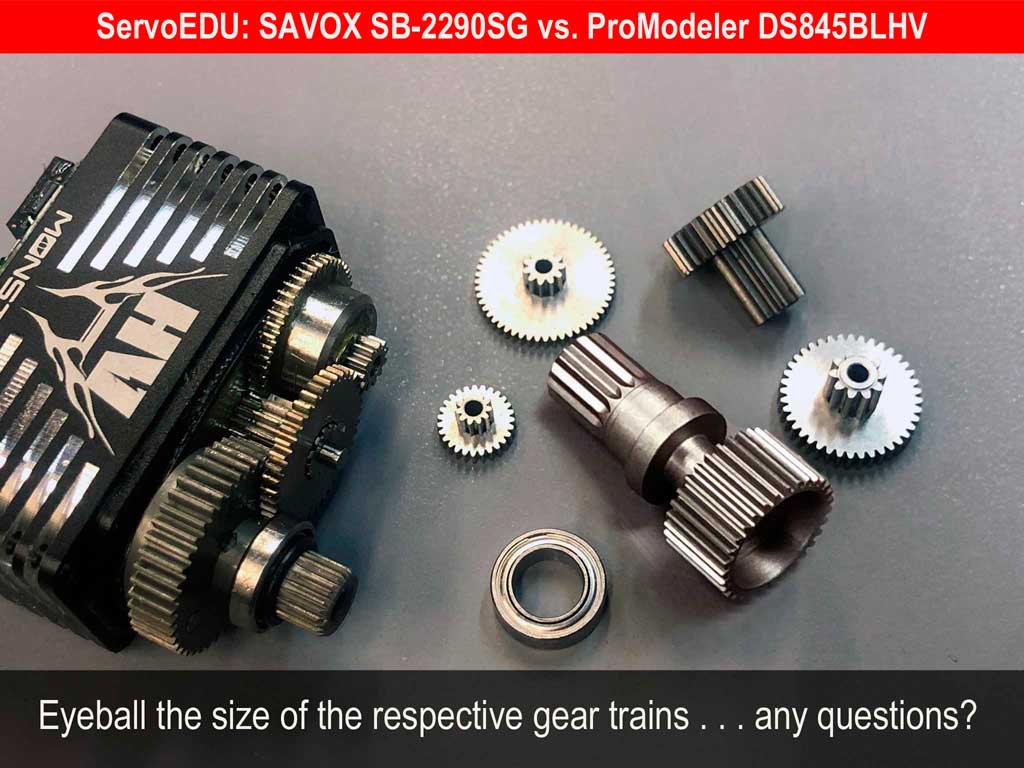
Part of what makes the entire ProModeler lineup better than our hobby-grade competitors is that unlike consumer servos, they're built to meet military standards (and subjected to these tests).
MIL-STD-810G-Part 16
- Shock - Test Method 516.6
- Vibration - Test Method 514.6
- Rain - Test Method 514.5
No two ways about it - they're better. Means you get more bang for your buck.

Finally, there's a 5th servo I'd like to bring to your attention. It's the DS490BHV, a low profile BLS2 class servo. Maybe this one floats your boat, dunno, hard to say.
Used a lot in RC Cars for it's shorter design height, it may be perfect for your rig. Another common use is for axle-mounting (think portal axles with the servo installed right on the housing). A possible advantage for you is it weighs less than the DS635BLHV.
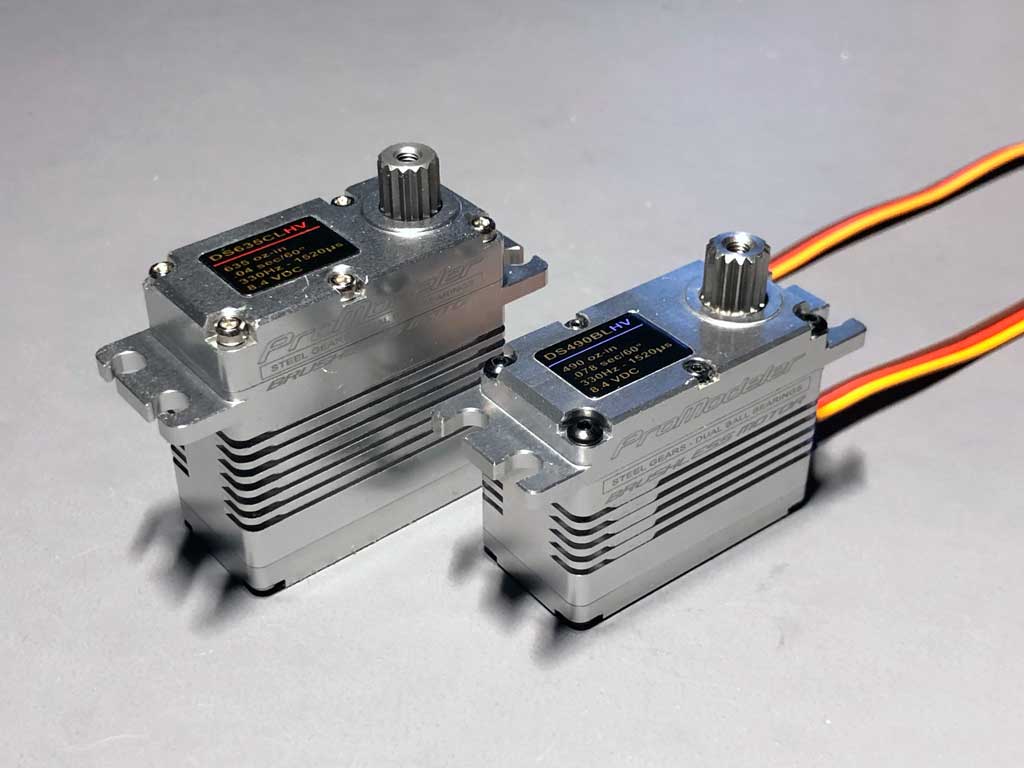
- DS490BLHV juxtaposed with the standard height DS635BLHV

Summary
Five servos suitable for the TEKNO SCT410 2.0 from which amongst them, one is sure to be the best for you. Which? Dunno, we're like a broken record . . . it depends.
Last thing. Maybe you've heard you can buy alloy-case servos off Amazon for cheap. it's true. How do they compare to a ProModeler servo? night and day, eyeball this to see what you get for your money.
Why would we show you a competitor costing 2/3 as much? Simple, there's no hiding from it and we'd rather take the bull by the horns and show you where we believe ours wins despite their better price. After all, seeing is believing!
Any further questions, suggestion for this article, etc. then just reach
out to me at 407-302-3361, or via email: info@promodeler.com